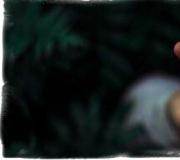Ivan Timofeevich is a kind but weak man. A.I
Alexander Ivanovich Kuprin often in his works painted an ideal image of a “natural” person, one who is not subject to the corrupting influence of light, whose soul is pure, free, who is close to nature, lives in it, lives with it in one impulse. A striking example of the disclosure of the theme of a “natural” person is the story “Olesya”.
The story described in the story did not appear by chance. One day A.I. Kuprin visited the landowner Ivan Timofeevich Poroshin in Polesie, who told the writer the mysterious story of his relationship with a certain witch. It was this story, enriched with artistic fiction, that formed the basis of Kuprin’s work.
The first publication of the story took place in the magazine “Kievlyanin” in 1898; the work bore the subtitle “From Memories of Volyn,” which emphasized the real basis of the events taking place in the story.
Genre and direction
Alexander Ivanovich worked at the end of the 19th and beginning of the 20th century, when a controversy gradually began to flare up between two directions: realism and modernism, which was just beginning to make itself known. Kuprin belongs to the realistic tradition in Russian literature, so the story “Olesya” can easily be classified as a realistic work.
The genre of the work is a story, since it is dominated by a chronicle plot, reproducing the natural course of life. The reader lives through all the events, day after day, following the main character Ivan Timofeevich.
The essence
The action takes place in the small village of Perebrod, Volyn province, on the outskirts of Polesie. The young gentleman-writer is bored, but one day fate takes him to the swamp to the house of the local witch Manuilikha, where he meets the beautiful Olesya. A feeling of love flares up between Ivan and Olesya, but the young sorceress sees that death awaits her if she links her fate with an unexpected guest.
But love is stronger than prejudice and fear, Olesya wants to deceive fate. A young witch goes to church for the sake of Ivan Timofeevich, although she is prohibited from entering there due to her occupation and origin. She makes it clear to the hero that she will commit this brave act, which could lead to irreparable consequences, but Ivan does not understand this and does not have time to save Olesya from the angry crowd. The heroine is severely beaten. In revenge, she sends a curse on the village, and that same night a terrible thunderstorm occurs. Knowing the power of human anger, Manuilikha and her pupil hastily leave the house in the swamp. When a young man comes to this home in the morning, he finds only red beads, as a symbol of his short but true love with Olesya.
The main characters and their characteristics
The main characters of the story are the master writer Ivan Timofeevich and the forest witch Olesya. Completely different, they got together, but could not be happy together.
- Characteristics of Ivan Timofeevich. This is a kind person, sensitive. He was able to discern a living, natural principle in Oles, because he himself had not yet been completely killed by secular society. The mere fact that he left noisy cities for a village speaks volumes. The heroine is not just a beautiful girl for him, she is a mystery to him. This strange healer believes in conspiracies, tells fortunes, communicates with spirits - she is a witch. And all this attracts the hero. He wants to see and learn something new, real, not covered up by falsehood and far-fetched etiquette. But at the same time, Ivan himself is still at the mercy of the world, he is thinking about marrying Olesya, but he is confused by how she, a savage, can appear in the halls of the capital.
- Olesya is the ideal of a “natural” person. She was born and lived in the forest, nature was her educator. Olesya’s world is a world of harmony with the surrounding world. In addition, she is in harmony with her inner world. We can note the following qualities of the main character: she is wayward, straightforward, sincere, she does not know how to pretend or pretend. The young witch is smart and kind; one only has to remember the reader’s first meeting with her, because she was tenderly carrying chicks in her lap. One of Olesya’s main traits can be called insubordination, which she inherited from Manuilikha. They both seem to be against the whole world: they live aloof in their swamp, they do not profess an official religion. Even knowing that you can’t escape fate, the young sorceress still tries, consoles herself with the hope that everything will work out for her and Ivan. She is original and unshakable, despite the fact that love is still alive, she leaves, leaves everything, without looking back. The image and characteristics of Olesya are available.
Themes
- The main theme of the story— Olesya’s love, her readiness for self-sacrifice — is the center of the work. Ivan Timofeevich was lucky to meet a real feeling.
- Another important semantic branch is the theme of the confrontation between the ordinary world and the world of natural people. Residents of villages, capitals, Ivan Timofeevich himself are representatives of everyday thinking, permeated with prejudices, conventions, and clichés. The worldview of Olesya and Manuilikha is freedom and open feelings. In connection with these two heroes, the theme of nature appears. The environment is the cradle that raised the main character, an irreplaceable helper, thanks to which Manuilikha and Olesya live away from people and civilization without need, nature gives them everything they need for life. This topic is covered most fully in this one.
- The role of landscape in the story is huge. It is a reflection of the feelings of the characters and their relationships. So, at the beginning of a romance we see a sunny spring, and at the end the break in relations is accompanied by a strong thunderstorm. We wrote more about this in this.
Problems
The problems of the story are varied. Firstly, the writer acutely depicts the conflict between society and those who do not fit into it. So, once they brutally drove Manuilikha out of the village and beat Olesya herself, although both sorceresses did not show any aggression towards the villagers. Society is not ready to accept those who differ from them in at least some way, who do not try to pretend, because they want to live by their own rules, and not according to the template of the majority.
The problem of attitude towards Olesya manifests itself most clearly in the scene of her going to church. For the Russian Orthodox people of the village, it was a real insult that the one who serves evil spirits, in their opinion, appeared in the temple of Christ. At the church, where people ask for God's mercy, they themselves administered cruel and merciless judgment. Perhaps the writer wanted, on the basis of this antithesis, to show that society has distorted the idea of the righteous, the good, and the just.
Meaning
The idea of the story is that people who grew up far from civilization turn out to be much nobler, more delicate, more polite and kinder than “civilized” society itself. The author hints that herd life dulls the individual and erases his individuality. The crowd is submissive and indiscriminate, and is often dominated by its worst members rather than its best. Primitive instincts or acquired stereotypes, such as misinterpreted morality, direct the collective towards degradation. Thus, the inhabitants of the village show themselves to be greater savages than the two witches living in the swamp.
Kuprin's main idea is that people must turn back to nature, must learn to live in harmony with the world and with themselves, so that their cold hearts will melt. Olesya tried to open the world of real feelings to Ivan Timofeevich. He couldn't understand it in time, but the mysterious witch and her red beads will remain in his heart forever.
Conclusion
Alexander Ivanovich Kuprin, in his story “Olesya,” tried to create an ideal of man, show the problems of the artificial world, and open people’s eyes to the driven and immoral society that surrounds them.
The life of the wayward, unshakable Olesya was to some extent destroyed by the touch of the secular world in the person of Ivan Timofeevich. The writer wanted to show that we ourselves destroy the beautiful things that fate gives us, simply because we are blind, blind in soul.
Criticism
The story “Olesya” is one of the most famous works of A.I. Kuprina. The strength and talent of the story were appreciated by the writer’s contemporaries.
K. Barkhin called the work a “forest symphony,” noting the smoothness and beauty of the work’s language.
Maxim Gorky noted the youth and spontaneity of the story.
Thus, the story “Olesya” occupies an important place, both in the work of A.I. himself. Kuprin, and in the history of Russian classical literature.
Interesting? Save it on your wall!Ivan Timofeevich (Vanechka) is a storyteller, urban intellectual, and aspiring writer.
I.T. On official business he ends up in Polesie. There, while hunting and lost in the forest, the hero meets the beautiful Alena (Olesya, in Polesie).
After this meeting, the image of Olesya could not leave I.T.’s head: he found in the girl an innate nobility, “graceful moderation.” Attracted I.T. and the girl’s “reputation as a witch,” her “life in the forest thicket.” But most of all the hero was fascinated by Olesya’s “integral, original nature, ... mind.”
During the second meeting, the girl tells fortunes to the hero, naming his main traits: “although kind, he is only weak... Kindness... is not good, not cordial. “I am not a master of my word,” I am “painfully eager” for women. He will not be able to love anyone, because “his heart... is cold, lazy.” As a result, Olesya predicts I.T. “great love on the part of the lady of clubs,” through which “she will accept great shame.” By a fatal coincidence, Olesya herself soon falls in love with the “baric” I.T. The characters begin a relationship. I.T. sets a condition for the girl: either he or her witchcraft. The hero persuades Olesya to go to church. There the village women attack her like a witch. Having come to Olesya, I.T. finds her ill from the fear and humiliation she experienced. The next day after the incident, returning to the girl again, the hero discovers that “the hut was empty.” And only a thread of red corals hung on the window reminded of Oles. I.T. almost immediately comes to terms with what happened.
The theme of love occupies a special place in the work of A. I. Kuprin. The writer gave us three stories united by this wonderful theme - “The Garnet Bracelet”, “Olesya” and “Shulamith”. Kuprin showed different facets of this feeling in each of his works...
Kuprin's story "Olesya" cannot leave the reader indifferent. The love story of a beautiful witch girl and a young gentleman is both tragic and beautiful. Kuprin creates a fabulous image of a Polesie beauty. There is nothing artificial about Olesya, she...
Filled with sin, without reason and will, a person is fragile and vain. Everywhere you look, only losses and pains torment his flesh and soul for a whole century... As soon as some leave, they are replaced by others, Everything in the world is continuous suffering for him: His friends, enemies, loved ones,...
In the works of A. I. Kuprin, the theme of love is embodied in many human destinies and experiences. It is not just interest and psychological process that gave birth to this rich world. Love in Kuprin’s works appears as great and natural,...
Having become acquainted with the work of A.I. Kuprin, I noted for myself the main theme of his works - the glorification of pure, immaculate, generous love. I turned the last page of the story “Olesya” - my favorite story by A. I. Kuprin. "Olesya"...
“Olesya” Kuprin A.I.
Ivan Timofeevich (Vanechka) is a storyteller, urban intellectual, and aspiring writer.
I.T. On official business he ends up in Polesie. There, while hunting and lost in the forest, the hero meets the beautiful Alena (Olesya, in Polesie).
After this meeting, the image of Olesya could not leave I.T.’s head: he found in the girl an innate nobility, “graceful moderation.” Attracted I.T. and the girl’s “reputation as a witch,” her “life in the forest thicket.” But most of all the hero was fascinated by Olesya’s “integral, original nature, ... mind.”
During the second meeting, the girl tells fortunes to the hero, naming his main traits: “although kind, he is only weak... Kindness... is not good, not cordial. “I am not a master of my word,” I am “painfully eager” for women. He will not be able to love anyone, because “his heart... is cold, lazy.” As a result, Olesya predicts I.T. “great love on the part of the lady of clubs,” through which “she will accept great shame.” By a fatal coincidence, Olesya herself soon falls in love with the “baric” I.T. The characters begin a relationship. I.T. sets a condition for the girl: either he or her witchcraft. The hero persuades Olesya to go to church. There the village women attack her like a witch. Having come to Olesya, I.T. finds her ill from the fear and humiliation she experienced. The next day after the incident, returning to the girl again, the hero discovers that “the hut was empty.” And only a thread of red corals hung on the window reminded of Oles. I.T. almost immediately comes to terms with what happened.




